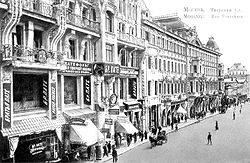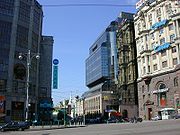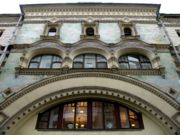
Tverskaya Street
Encyclopedia

Moscow
Moscow is the capital, the most populous city, and the most populous federal subject of Russia. The city is a major political, economic, cultural, scientific, religious, financial, educational, and transportation centre of Russia and the continent...
, Russia
Russia
Russia or , officially known as both Russia and the Russian Federation , is a country in northern Eurasia. It is a federal semi-presidential republic, comprising 83 federal subjects...
. The street runs from the central Manege Square
Manege Square
Manezhnaya or Manege Square is a large pedestrian open space at the heart of Moscow bound by the Hotel Moskva to the east, the State Historical Museum and the Alexander Garden to the south, the Moscow Manege to the west, and the 18th-century headquarters of the Moscow State University to the...
north-west in the direction of Saint Petersburg
Saint Petersburg
Saint Petersburg is a city and a federal subject of Russia located on the Neva River at the head of the Gulf of Finland on the Baltic Sea...
and terminated at the Garden Ring
Garden Ring
The Garden Ring, also known as the "B" Ring , is a circular avenue around the central Moscow, its course corresponding to what used to be the city ramparts surrounding Zemlyanoy Gorod in the 17th century....
, giving its name to Tverskoy District. The route continues further as First Tverskaya-Yamskaya Street, Leningradsky Prospekt
Leningradsky Prospekt
Leningradsky Prospekt , or Leningrad Avenue, is a major arterial avenue in Moscow, Russia. It continues the path of Tverskaya Street and 1st Tverskaya-Yamskaya Street north-west from Belorussky Rail Terminal, and changes the name once again to Leningrad Highway past the Sokol metro station...
and Leningradskoye Shosse.
Middle Ages to 18th century
Tourists are told that Tverskaya Street existed as early as the 12th century. Its importance for the medieval city was immense, as it connected Moscow with its superior, and later chief rival, TverTver
Tver is a city and the administrative center of Tver Oblast, Russia. Population: 403,726 ; 408,903 ;...
. At that time, the thoroughfare crossed the Neglinnaya River
Neglinnaya River
The Neglinnaya River , also known as Neglimna, Neglinna, Neglinka , is a 7.5-km long underground river in the central part of Moscow and a tributary of the Moskva River. It flows in the tunnels under Samotechnaya Street, Tsvetnoy Boulevard, Neglinnaya Street and Alexander Garden and Zaryadye...
. The first stone bridge across the Neglinnaya was set up in 1595.
In the 17th and 18th centuries, Tverskaya Street was renowned as the centre of Moscow's social life. The nobility considered it fashionable to settle in this district. Among the Palladian mansions dating from the reign of Catherine the Great are the residence of the mayor of Moscow (1778–82, rebuilt in ), and the English Club (1780s). The mayor's residence among a number of other historic buildings was moved about 14 meters for the widening of the Gorky street during Stalin's time. On the square before it stands a statue of the legendary founder of Moscow, Yuri Dolgoruky, erected for the city's 800th anniversary.
During the imperial period, the importance of the thoroughfare was highlighted by the fact that it was through this street that the tsars arrived from the Northern capital to their Kremlin residence. Several triumphal arch
Triumphal arch
A triumphal arch is a monumental structure in the shape of an archway with one or more arched passageways, often designed to span a road. In its simplest form a triumphal arch consists of two massive piers connected by an arch, crowned with a flat entablature or attic on which a statue might be...
es were constructed to commemorate the coronation ceremonies. In 1792, the Tverskaya Square was laid out before the residence of the governor of Moscow as a staging ground for mass processions and parades. In 1947, the square was decorated with an equestrian statue of Prince Yury Dolgoruky, founder of Moscow.
19th century

Eugene Onegin
Eugene Onegin is a novel in verse written by Alexander Pushkin.It is a classic of Russian literature, and its eponymous protagonist has served as the model for a number of Russian literary heroes . It was published in serial form between 1825 and 1832...
:
- The columns of the city gate
- Gleam white; the sleigh, more swift than steady,
- Bumps down Tverskaya Street already.
- Past sentry-boxes now they dash,
- Past shops and lamp-posts, serfs who lash
- Their nags, huts, mansions, monasteries,
- Parks, pharmacies, BukharaBukharaBukhara , from the Soghdian βuxārak , is the capital of the Bukhara Province of Uzbekistan. The nation's fifth-largest city, it has a population of 263,400 . The region around Bukhara has been inhabited for at least five millennia, and the city has existed for half that time...
ns, guards, - Fat merchants, Cossacks, boulevards,
- Old women, boys with cheeks like cherries,
- Lions on gates with great stone jaws,
- And crosses black with flocks of daws.
Towards the end of the 19th century, the street was reconstructed, with stately neoclassical mansions giving way to grandiose commercial buildings in an eclectic mixture of historical styles. A characteristic edifice of the time is the eclectic
Eclecticism
Eclecticism is a conceptual approach that does not hold rigidly to a single paradigm or set of assumptions, but instead draws upon multiple theories, styles, or ideas to gain complementary insights into a subject, or applies different theories in particular cases.It can sometimes seem inelegant or...
National Hotel (1901), whose interior is a landmark of Russian Art Nouveau
Art Nouveau
Art Nouveau is an international philosophy and style of art, architecture and applied art—especially the decorative arts—that were most popular during 1890–1910. The name "Art Nouveau" is French for "new art"...
. In 1888 the actor, theatre director and founder of the Moscow Art Theatre
Moscow Art Theatre
The Moscow Art Theatre is a theatre company in Moscow that the seminal Russian theatre practitioner Constantin Stanislavski, together with the playwright and director Vladimir Nemirovich-Danchenko, founded in 1898. It was conceived as a venue for naturalistic theatre, in contrast to the melodramas...
, Constantin Stanislavski, rented the Ginzburg House on the street and had it converted into a luxurious clubhouse with its own large stage and several exhibition rooms, in order to house his newly-formed Society of Art and Literature. The Society gave its last performance there on 3 January 1891 and the building burnt down on the night of 10 January.
Modern history

Russian Revolution of 1917
The Russian Revolution is the collective term for a series of revolutions in Russia in 1917, which destroyed the Tsarist autocracy and led to the creation of the Soviet Union. The Tsar was deposed and replaced by a provisional government in the first revolution of February 1917...
and the rise of Stalinist architecture
Stalinist architecture
Stalinist architecture , also referred to as Stalinist Gothic, or Socialist Classicism, is a term given to architecture of the Soviet Union between 1933, when Boris Iofan's draft for Palace of the Soviets was officially approved, and 1955, when Nikita Khrushchev condemned "excesses" of the past...
in mid-1930s, the street acquired three modernist buildings - constructivist
Constructivist architecture
Constructivist architecture was a form of modern architecture that flourished in the Soviet Union in the 1920s and early 1930s. It combined advanced technology and engineering with an avowedly Communist social purpose. Although it was divided into several competing factions, the movement produced...
Izvestia Building by Grigory Barkhin (1925–1927, Pushkin Square
Pushkin Square
Pushkinskaya Square or Pushkin Square in Moscow, historically known as Strastnaya Square and renamed for Alexander Pushkin in 1937, is located at the junction of the Boulevard Ring and Tverskaya Street, 2 km northwest of the Kremlin...
), Central Telegraph Building (1927–29, 5 Tverskaya), a modernist masterpiece by Ivan Rerberg
Ivan Rerberg
Ivan Ivanovich Rerberg was a Russian civil engineer, architect and educator active in Moscow in 1897–1932. Rerberg's input to present-day Moscow include Kiyevsky Rail Terminal, Central Telegraph building and the Administration building of Moscow Kremlin...
, and a stern "black cube
Cube
In geometry, a cube is a three-dimensional solid object bounded by six square faces, facets or sides, with three meeting at each vertex. The cube can also be called a regular hexahedron and is one of the five Platonic solids. It is a special kind of square prism, of rectangular parallelepiped and...
" of Lenin Institute in Tverskaya Square (1926) by Stepan Chernyshyov.
Further expansion occurred in line with Stalin's 1935 master plan. During that period, all the churches and most other historic buildings were torn down in order to widen the street and replace low-rise buildings with larger, early Stalinist apartment blocks and government offices. Arkady Mordvinov
Arkady Mordvinov
Arkady Grigoryevich Mordvinov was a Soviet architect and construction manager, notable for Stalinist architecture of Tverskaya Street, Leninsky Avenue, Hotel Ukraina skyscraper in Moscow and his administrative role in Soviet construction industry and architecture.-VOPRA years:Mordvinov was born in...
, who handled this ambitious project, retained some historical buildings, like the ornately decorated Savvinskoye Podvorye by Ivan Kuznetsov. This building was moved to a new foundation north from the new street line, and is now completely enclosed inside Mordvinov's Stalinist block at 6, Tverskaya Street.
The project was only partially completed before World War II
World War II
World War II, or the Second World War , was a global conflict lasting from 1939 to 1945, involving most of the world's nations—including all of the great powers—eventually forming two opposing military alliances: the Allies and the Axis...
; more Stalinist blocks appeared in 1940s and 1950s, still leaving a lot of 19th century buildings. Most of them were torn down later, with a few exceptions like Yermolova Theatre
Yermolova Theatre
The Yermolova Theatre is a theatre company in Moscow, under the artistic direction of Vladimir Andreyev . The building itself, built in the 1830s, is one of the largest on Tverskaya Street. The theatre company was founded by graduates of the Maly Theatre studio in 1925, and named after the great...
still standing. Intourist Hotel, a 23-story tower built in 1970, has been demolished in 2002 and replaced with an equally controversial hotel block.
Layout and functions
Tverskaya Street runs from the Manege SquareManege Square
Manezhnaya or Manege Square is a large pedestrian open space at the heart of Moscow bound by the Hotel Moskva to the east, the State Historical Museum and the Alexander Garden to the south, the Moscow Manege to the west, and the 18th-century headquarters of the Moscow State University to the...
through the Tverskoy District and the crossing with the Boulevard Ring
Boulevard Ring
The Boulevard Ring is Moscow's second centremost ring road . Boulevards form a semicircular chain along the western, northern and eastern sides of the historical White City of Moscow; in the south the incomplete ring is terminated by the embankments of Moskva River...
, known as Pushkin Square
Pushkin Square
Pushkinskaya Square or Pushkin Square in Moscow, historically known as Strastnaya Square and renamed for Alexander Pushkin in 1937, is located at the junction of the Boulevard Ring and Tverskaya Street, 2 km northwest of the Kremlin...
, to the Garden Ring
Garden Ring
The Garden Ring, also known as the "B" Ring , is a circular avenue around the central Moscow, its course corresponding to what used to be the city ramparts surrounding Zemlyanoy Gorod in the 17th century....
. Its extension, First Tverskaya-Yamskaya Street, continues further north-west right up to Belorussky Rail Terminal
Belorussky Rail Terminal
Belorussky Rail Terminal is one of nine rail terminals in Moscow. It was opened in 1870 and rebuilt in its current form in 1910-12.-Long distance:-Other destinations:-Suburban destinations:...
(Tverskaya Zastava Square), changing its name again into Leningradsky Prospekt
Leningradsky Prospekt
Leningradsky Prospekt , or Leningrad Avenue, is a major arterial avenue in Moscow, Russia. It continues the path of Tverskaya Street and 1st Tverskaya-Yamskaya Street north-west from Belorussky Rail Terminal, and changes the name once again to Leningrad Highway past the Sokol metro station...
. It keeps the same direction before diverging into Volokolamskoye Shosse and Leningradskoye Shosse (literally, Leningrad
Saint Petersburg
Saint Petersburg is a city and a federal subject of Russia located on the Neva River at the head of the Gulf of Finland on the Baltic Sea...
Expressway).
Tverskaya Street is the most expensive shopping street in Moscow and Russia
Russia
Russia or , officially known as both Russia and the Russian Federation , is a country in northern Eurasia. It is a federal semi-presidential republic, comprising 83 federal subjects...
. According to an index published by global real estate company Colliers International in 2008 it is now the 3rd most expensive street based on commercial rents in the world. It is the center of the city's nightlife and entertainment
Entertainment
Entertainment consists of any activity which provides a diversion or permits people to amuse themselves in their leisure time. Entertainment is generally passive, such as watching opera or a movie. Active forms of amusement, such as sports, are more often considered to be recreation...
.
Reconstruction plan, 2007-2009
Plans for the reconstruction of Tverskaya radius into a grade-separated freeway, already under way in remote parts of the route (see Leningradsky Prospekt Reconstruction for a complete schedule), have been authorized for Tverskaya Zastava and Pushkin SquarePushkin Square
Pushkinskaya Square or Pushkin Square in Moscow, historically known as Strastnaya Square and renamed for Alexander Pushkin in 1937, is located at the junction of the Boulevard Ring and Tverskaya Street, 2 km northwest of the Kremlin...
in April, 2007, to be completed in 2009; work in already underway at the first location. Both squares will acquire complex multi-level, grade-separated crossings and underground shopping malls, despite objections from preservationist
Preservationist
Preservationist is generally understood to mean historic preservationist: one who advocates to preserve architecturally or historically significant buildings, structures, objects or sites from demolition or degradation...
s and traffic experts.
Sources
- Benedetti, Jean. 1999. Stanislavski: His Life and Art. Revised edition. Original edition published in 1988. London: Methuen. ISBN 0-413-52520-1.

